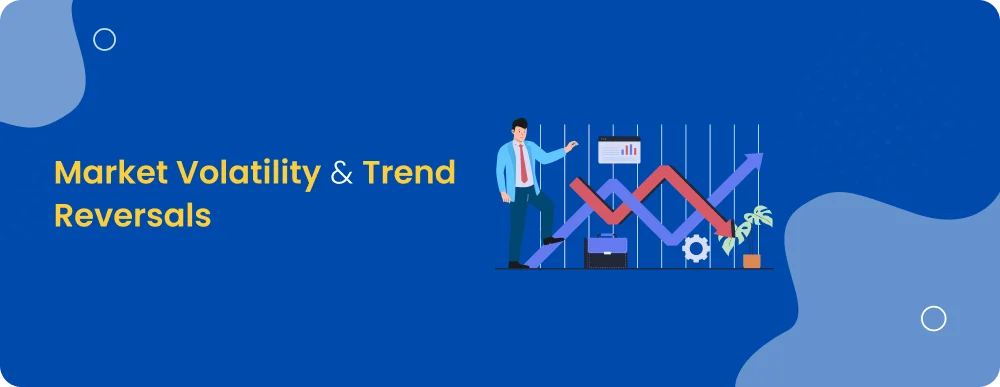Market Volatility & Trend Reversals
Noor Kaur
29 Apr 2025Tags:
Featured
Most traders misread market reversals because they don’t understand the underlying role of liquidity, volatility, and sentiment. You're not alone if caught in a reversal trade that failed fast or reversed too slowly. This blog focuses on the patterns that matter when dealing with trend reversal stocks in volatile markets. Read along!
What is Market Volatility?
Market volatility refers to how quickly and sharply the price of a security or market index moves over a period. The market is considered volatile when prices shift rapidly, either up or down. This movement reflects the level of uncertainty or risk among investors.
Volatility is commonly measured using standard deviation (a number that shows how spread out returns are from the average). A higher value means the prices are swinging widely. In contrast, a lower value suggests that prices stay within a narrow range.
For example, if a stock index moves more than 1% in either direction daily, it’s generally viewed as a sign of high volatility.
What is a Trend Reversal in Financial Markets?
A trend reversal happens when the direction of a market trend changes. If the market has been moving upwards and then starts falling, that’s a reversal. The same applies when a long downtrend shifts into an upward movement. Simply, a market reversal is a turning point in price movement.
You’ll often hear the term trend reversal when discussing technical analysis. Traders look for trend reversal patterns—specific chart formations or signals that hint the current direction might not continue for long. Spotting a downtrend reversal early, for instance, can help you take a long position before prices climb.
Key Signs or Indicators of a Trend Reversal
Spotting trend reversals early can help you avoid losses or catch new price movements as they begin. But identifying a market reversal isn’t about guessing — it involves reading clear signs backed by technical analysis and market activity. Here's how you can do that.
1. Price Action at Support and Resistance Levels
Price action shows how prices move on a chart over time. One of the first signs of a possible reversal is when the price breaks a key support (floor) or resistance (ceiling) level, especially if it happens with higher volume.
If the price steadily rises and suddenly breaks below support with strong momentum, it could signal a stock market reversal. Similarly, a downtrend reversal becomes more likely when the price breaks above a resistance line after a long fall.
You should also watch how the price behaves after the breakout. If the price retests the broken level and continues in the new direction, that’s another confirmation.
2. Candlestick Patterns That Signal Change
Certain candlestick formations can show shifts in sentiment. A Hammer at the end of a downward move suggests buyers are stepping in, hinting at a possible upward reversal. A Doji, which means indecision, often appears before trend reversals — especially after a strong move in one direction. An Engulfing pattern, where a candle fully covers the previous one, indicates a strong momentum shift.
3. Momentum Indicators Like RSI and MACD
The Relative Strength Index (RSI) measures how fast and how far prices move. If RSI exceeds 70, the asset is likely overbought — meaning prices may soon fall. If it falls below 30, the asset might be oversold, suggesting a possible upward reversal.
MACD (Moving Average Convergence Divergence) shows the relationship between two moving averages. When the MACD line crosses below the signal line, it suggests weakening momentum, possibly leading to a market reversal. Bullish or bearish divergences between MACD and price also signal that the current trend is losing strength.
4. Volume Spikes at Key Levels
Volume matters because it shows how many people are trading at a given price level. When you see a price move supported by higher volume, especially at support or resistance, it gives more weight to the signal. A sudden rise in volume during a downtrend reversal shows increased buying interest. If the price falls and volume remains low, that move is weak and could reverse soon.
5. Divergence Between Price and Indicators
Divergence happens when the price moves in one direction, but an indicator like RSI or MACD moves in the opposite direction. This mismatch signals that the current trend is weakening. A bullish divergence (price making lower lows but indicator making higher lows) often appears before a price rise. Similarly, a bearish divergence suggests a coming fall.
How Market Volatility Affects Trend Reversals
In a volatile market, price movements tend to be sharp and erratic. For liquidity providers—those who facilitate trades by being willing to buy or sell shares—this means greater inventory risk. The more volatile a stock is, the riskier it becomes for investors to hold it, especially during order imbalances. As a result, they demand a higher return for supplying liquidity.
This is why trend reversals tend to be stronger in more volatile stocks. After extreme moves, you'll likely see faster price corrections because market participants adjust their positions quickly.
However, these reversals may not last long. The initial reaction is sharp, but the strength weakens soon after. If you're trading trend reversal stocks with high volatility, be prepared for quicker exits, and consider stop-loss levels seriously. A reversal in these cases can be fast, but the next move could just as easily go against you.
Strategies to Handle Market Volatility and Trend Reversals
Market volatility increases the chances of large price swings, leading to fast profits and quick losses. Some strategies to handle market volatility and trend reversals are:
Adjust Your Timeframes Based on Stock Characteristics
Fast reversals are common in high-volatility stocks. These require shorter holding periods and tighter stop-loss levels. In contrast, trend reversal stocks with low turnover often move more slowly, which gives you more time to build or exit positions gradually.
Use shorter timeframes for high-volatility, high-turnover stocks and longer timeframes for low-turnover ones. This helps align your strategy with the stock's behaviour rather than relying solely on technical patterns.
Avoid Overreacting to Initial Price Moves
Not every sharp price drop means a downtrend reversal is about to happen. In volatile conditions, prices often overshoot. If you jump in too early, you might get caught in a move that has not settled yet.
Wait for confirmation. That could mean a stabilisation in price, a pickup in volume, or a reversion to the stock’s recent average. Being patient during market reversals helps you avoid false entries.
Watch for Asymmetry in Risk and Reward
When volatility is high, the downside can be severe. If you’re trading a potential stock market reversal, ensure the potential upside outweighs the possible loss. Otherwise, it's not worth the risk.
For short-term trades, use pre-defined entry and exit points. For longer trades, monitor turnover and volatility signals—low turnover offers more persistent reversals, which are useful for extended positions.
Don’t Rely on Technicals Alone
Most reversal strategies use technical indicators like RSI (Relative Strength Index) or moving averages. These are useful but not always reliable during sharp market volatility. Supplement these with volatility measures (like average true range) and turnover data. These give you extra insight into the behaviour of liquidity providers and the likelihood of a sustained reversal.
The Role of Market Psychology in Trend Reversals
Price doesn’t move in isolation. During a major trend reversal, you often see a shift in how market participants react to new information. Here are some ways market psychology impacts trend reversals:
Herding Can Distort the Initial Signal
During a volatile phase, investors react similarly to news, buying or selling. This herding creates large price movements that may not reflect the stock’s value. A big move followed by a sharp reversal often comes from traders exiting those crowded positions once momentum fades.
Confirmation Bias Affects Timing
It’s common to hold onto a losing position because you expect a trend reversal. However, during high volatility, reversals are not always predictable. If you're trading based on what should happen instead of what is happening, you may hold positions longer than needed or exit too early.
Sentiment Shifts Slowly in Low-Turnover Stocks
In stocks with low trading activity, sentiment doesn't change overnight. If you're trading these for downtrend reversal opportunities, the reversal tends to build over time. Watch for sustained price moves, even if they start small. These are often more reliable than dramatic spikes.
Explore Our Investment Option:
Conclusion
Reversal strategies need more than just technical indicators. Volatility tells you how fast things can change, while turnover gives insight into how long those changes might last. Together, they can help you avoid chasing short-term moves and build a strategy across market conditions.
FAQs
What is the difference between a pullback and a trend reversal?
The difference between a pullback and a trend reversal lies in the duration and strength of the price move. A pullback is a short-term pause or dip within an existing trend, while trend reversals signal a change in the overall direction. For example, a downtrend reversal shifts the longer-term trend from falling to rising, while a pullback during a downtrend is temporary.
What risk management strategies help during market volatility?
Risk management strategies that help during market volatility include using smaller position sizes, setting tight stop-loss levels, and avoiding overexposure to highly volatile stocks. In phases of stock market reversal, it’s also important to avoid averaging down blindly and to wait for confirmation before re-entering.
How does market sentiment affect trend reversals?
Market sentiment affects trend reversals by driving emotional buying or selling, especially during uncertain periods. A shift from fear to optimism can lead to a market reversal, while panic selling often marks the end of a downtrend reversal.
What are the most reliable technical indicators for trend reversals?
The most reliable technical indicators for trend reversals include moving average crossovers, Relative Strength Index (RSI) divergence, and volume spikes. These tools help confirm whether a price move will likely lead to a market reversal or a short-term pullback. They are particularly useful when analysing trend reversal stocks.
How does algorithmic trading contribute to market volatility?
Algorithmic trading contributes to market volatility by executing large orders at high speeds, which can cause sharp price movements. During low-volume periods, these trades can trigger quick spikes or drops, increasing the chance of false signals during trend or stock market reversals.
Noor Kaur
29 Apr 2025Related blogs


How the Stock Market Works in India: A Guide | mastertrust
Have you ever wondered about the complexities of the stock market in India? If so, you're not alone. In this exten...


Role of Inflation in Long-Term Investment Planning
In Financial Planning, one of the things that plays a key role is the impact of inflation on your investments.


Understanding FERA vs. FEMA: Key Differences Explained | mastertrust
In the world of financial services and international trade, regulations play a crucial role in governing transaction


Understanding Negative Rate Bonds: Investor Strategies | mastertrust
Bonds are considered a popular investment avenue by Investors. The demand for negative yield bonds is on the rise
Sign up to our newsletter !
Share this article on
Recent articles
Tags:
Open a Demat Account in just 15 minutes !

Click on open
account below

Fill out some
basic details

Upload your
documents

Start trading in
24 Hours *
Commonly asked questions
Is Master Capital Services Limited SEBI registered?
Do you have a mobile app for Trading and Finance Management?
What services does mastertrust provide?
What is the minimum investment required to start trading with your company?
Is my personal and financial information secure with your company?
What is your customer support availability?





